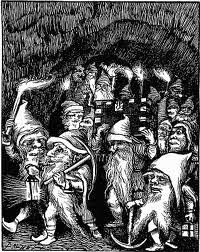George MacDonald was born in Scotland in 1824, he trained as a minister, but was prevented from preaching after he was accused of heresy, and he turned to writing to support his wife and 11 children. The Princess and the Goblin was published in 1872 in serial form in Good Words for the Young, a magazine that George MacDonald edited at the time.
 |
| MacDonald's daughter Irene (second from right) with Lewis Carroll Picture source |
MacDonald uses an omniscient first person narrator to tell Irene's story, and while that can be a bit intrusive at times, and sometimes 19th century writings can be a bit purple prosy, there is much to astonish the modern reader in the details and imagination on display. I love the descriptive passages about Irene's great-great grandmother, a kind of fairy god-mother figure (or maybe god, or is it really like Jane Eyre's Bertha?). Whatever she represents I find it rather amazing that a 19th century Scottish minister dreamt up a magical grandmother spinning spider webs in an attic room. She has a fire that burns in the shape of roses, and she may be or may not be a pigeon.
Irene wondered what she was going to do with her, but asked no questions- only starting a little when she found that she was going to lay her in the large silver bath; for as she looked into it, again she saw no bottom, but the stars shining miles away, as it seemed, in a great blue gulf.
Every princess needs her knight of course, and Irene meets up with a 13 year old miner's son, Curdie. They help each other, and battle the goblins together. The goblins are great characters too- driven underground by severe taxes imposed by a long ago king- they still bear a grudge against his descendants, and as they have become "misshapen in body they had grown in knowledge and cleverness." They have an intriguing weak spot, and an aversion to verse.
 |
| Original artwork by Arthur Hughes Picture source |
'Then you must believe without seeing,' said the princess;
'People must believe what they can, and those who believe more must not be hard upon those who believe less.'George MacDonald wrote a sequel called The Princess and Curdie. His other most famous children's work is At the Back of the North Wind. His fairy tales are apparently "minor masterpieces" according to the Cambridge Guide to Children's Books in English, particularly The Light Princess.
239/1001

3 comments:
This is so interesting! I especially like the background story of the author & the old photo....really very interesting. Thanks, Louise.
Somehow I missed the fact that the author was accused of heresy. Not so good when you are a minister back in those days, I suppose.
Now I'm curious to know a little more about this fellow. Off to find out....
Thanks for this post. Very helpful. Love the book! Leanne
Post a Comment